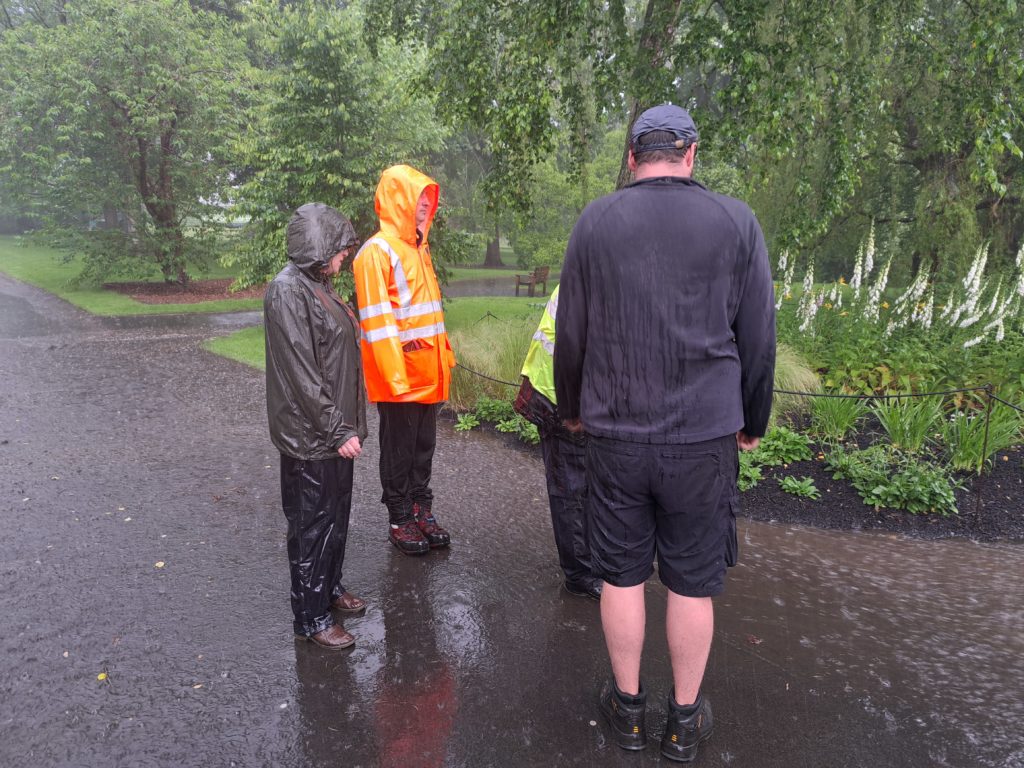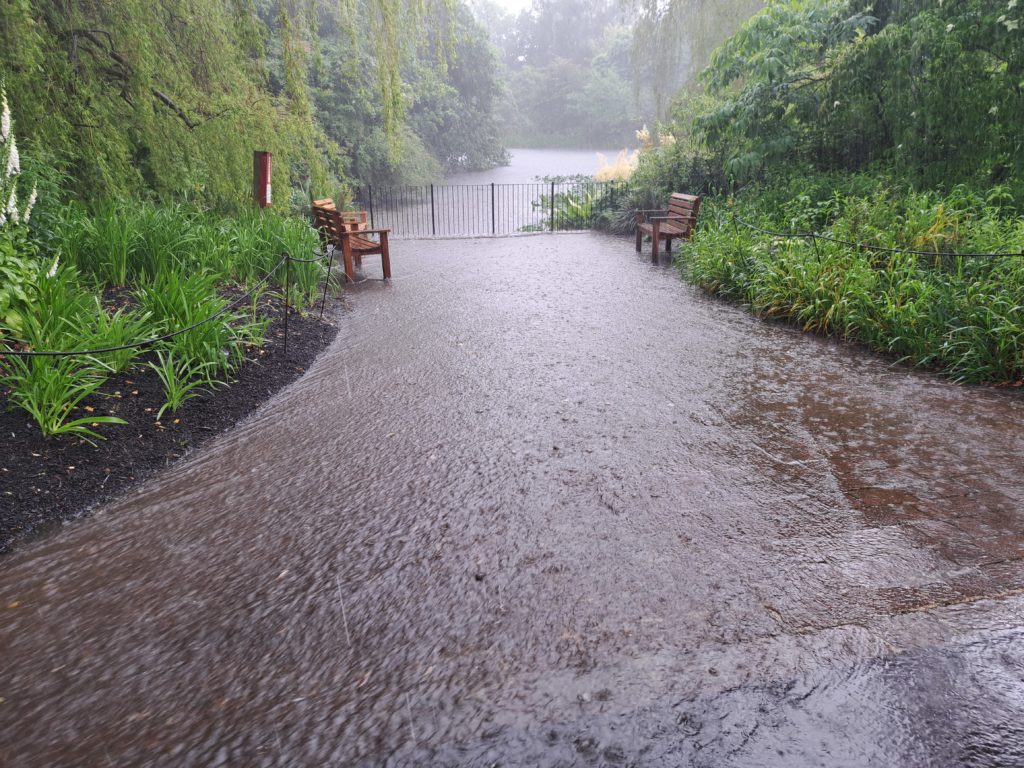On Friday 14 June 2024, RBGE experienced 11mm of rain in the span of 8 minutes.
To put into context, a typical rainy day (≥ 1mm precipitation, of which we historically average 1 every 3 days) in Edinburgh averages out to about 6mm of rain for the entire day. Two weeks ago, we experienced double that volume in less time than it takes to enjoy a cup of tea.
Science and Horticulture staff were out in the Garden when the rain hit—fortuitously, having a joint meeting about RBGE plans for our changing climate—and were able to witness the impacts in real time.
Our flagship nature-based solution, the rain garden, successfully contained all runoff from the hill above it and did not flood. Elsewhere in the garden, this was not the case. Paths flooded, water blisters formed under low-rooting grass lawns, and the force of water gouged mulch and dirt from beds.


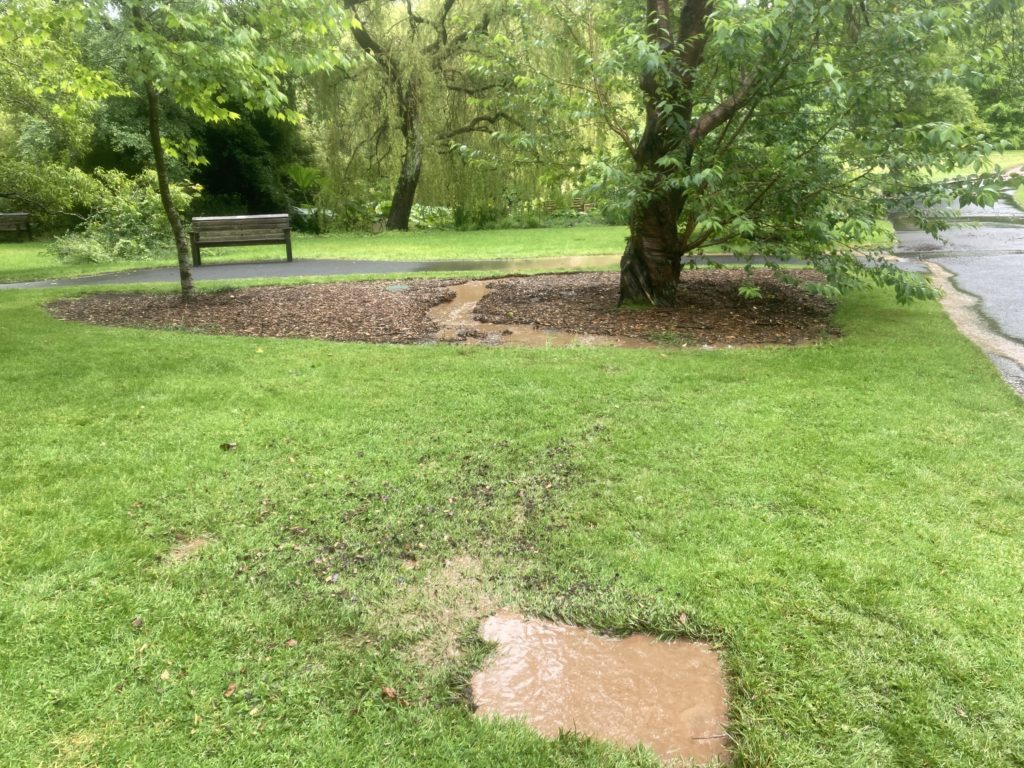
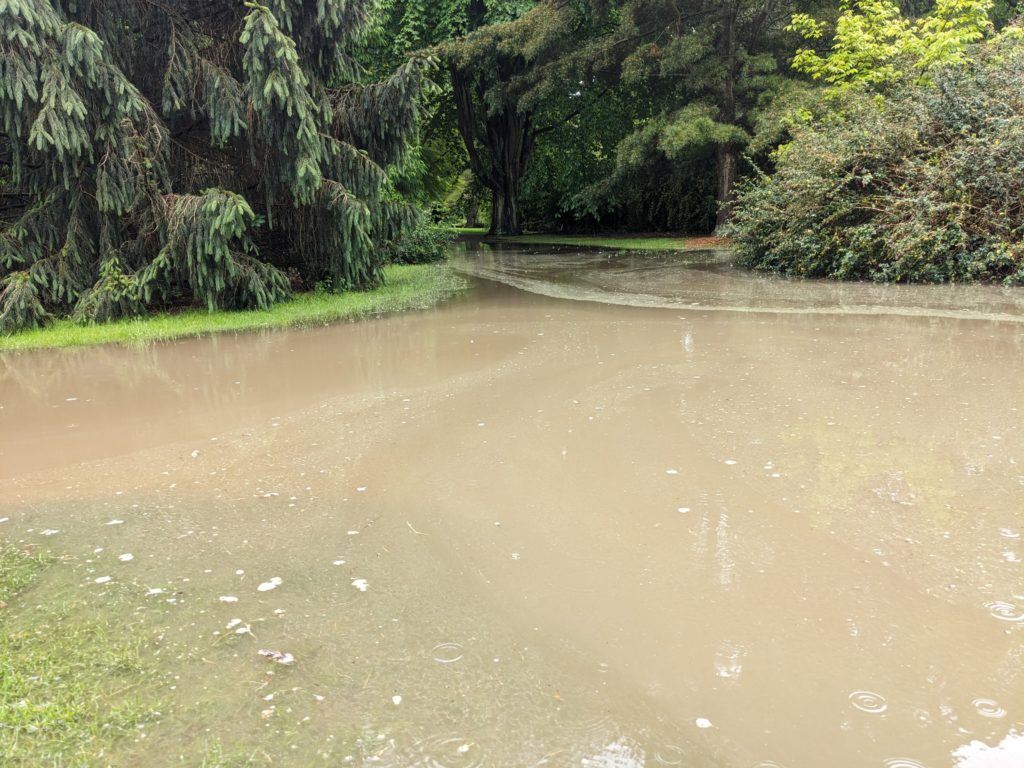
Cause and Effect
Our fair city is no stranger to (arguably) foul weather. One month ago at the Plants with Purpose research programme launch, Edinburgh again saw a heavy rainfall day, 52.6mm. The deluge was fantastic for showing the effectiveness of nature-based solutions in action, as the RBGE rain garden yet again successfully contained all the floodwater in its catchment. But in the grey-infrastructure-heavy wider city, four-hour tailbacks formed on roadways as multiple routes became impassable.
It is the increasing intensity of the rain that is catching the world off guard. To compare our water changes with wind, it is like we have been enjoying and have planned for summer breezes, when what we are now experiencing is a howling Scottish gale. The highest rain rate (analogous to the ‘biggest gust’) recorded by the RBGE weather station on the 14th occurred at 13:32, at a shocking 155.6 mm/hr.
The risk of not adapting to extreme weather events far outweighs the cost of implementing adaptation measures.
erin miller, rbge sustainability manager
The effects of these intense weather fluctuations are also felt within our buildings, putting the Estates and Facilities Team into untenable conditions of rapid emergency response. Within an hour of the rainfall event, major issues were reported across the estate:
- the Balfour Building—water ingress over electrical panels that control scientific freezers,
- Inverleith House—inches of flooding threatening basement archives,
- The John Hope Gateway—extreme leaks in multiple locations,
- Caledonian Hall—electrical damage from the rain that put in jeopardy that weekend’s events,
- Terrace Café—water pouring through a light fixture, and
- The Herbarium and Library—leaks through the windows.
Sustainability manager Erin Miller highlighted well the cascading and costly impacts of intense weather conditions on our Estates and built infrastructure:
“As rainfall intensity rises, drainage systems struggle to cope…Buildings face higher risks of leaks, water ingress, and flooding due to overwhelmed infrastructure, and this can cause damage to ceilings, walls, and electrical systems…The risk of not adapting to extreme weather events far outweighs the cost of implementing adaptation measures.”

Our changing weather means more than flooding, and current grey infrastructure solutions can’t cope. The sediment of beds and paths are being washed out in the wake of intense rains, filling surface drains in heartbeats. Legacy drains beneath the grass are immediately overwhelmed, turning previously flat lawns into astonishing water blisters. Our buildings are also taxed by the increased water – at current annual rainfall levels, just the John Hope Gateway building alone displaces more than one million litres of water per year.
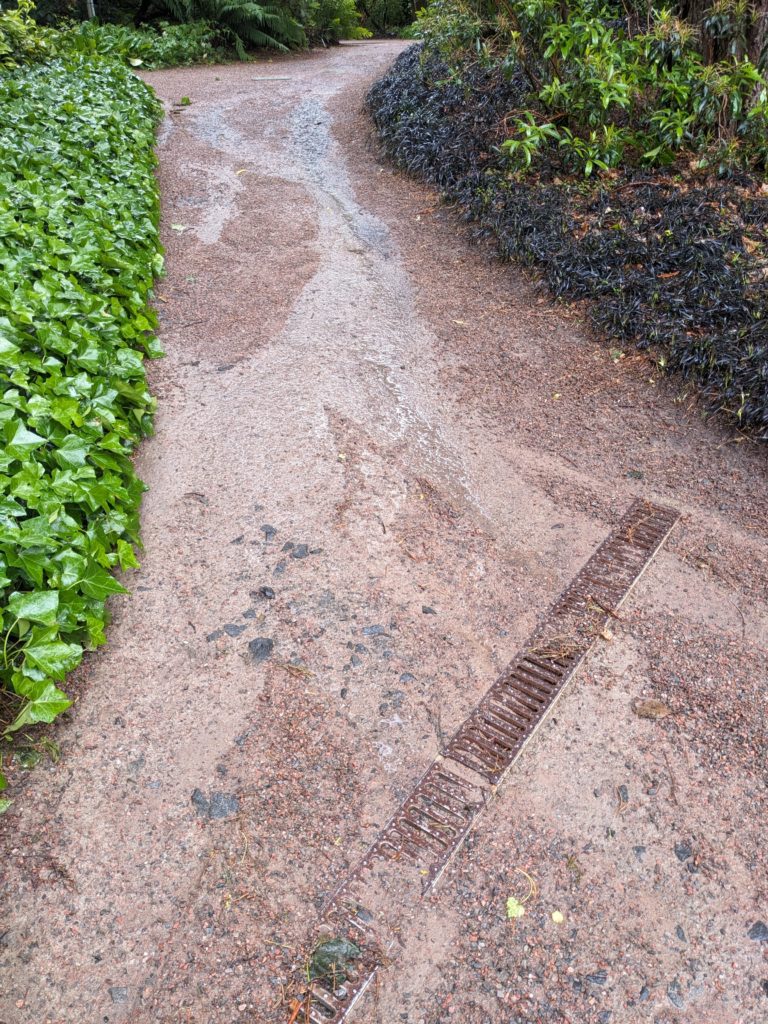
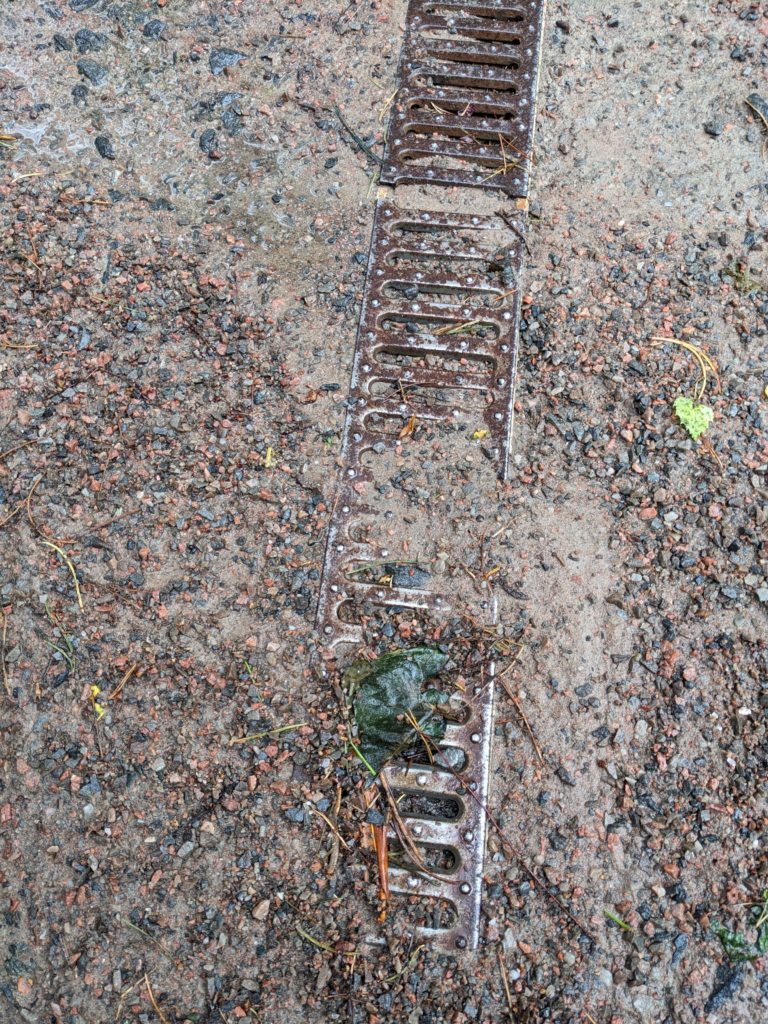
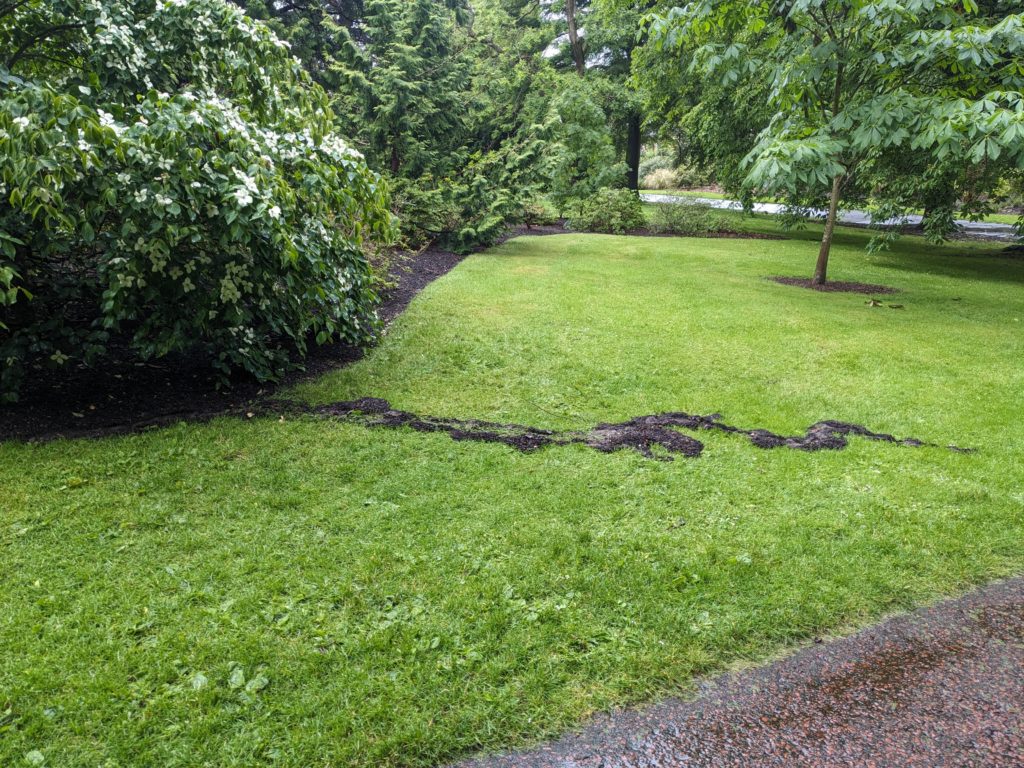

Dry spells between the rain storms are compounding the effects. Moving away from the familiar pattern of a light rain storm every few days, the new trend is intense, heavy storms followed by a week or more of dry weather. Plants become stressed, soil dries out and the crucial air pockets within it collapse, and both are less able to handle the inevitable water. A large amount of water falls within a very short amount of time onto ground that cannot soak it up, and city dwellers experience flooding conditions.
Rather than a strong focus on flooding, we need planning for both flooding and droughts. This planning practice is what Scottish Environment Protection Agency chief executive Nicole Paterson calls “water resilience.”
Planning for the Future
Traditional grey infrastructure solutions—for example, increasing the size or number of drains—is not a viable option, only pushing the problem downstream and overwhelming sewers and rivers faster. We need to capture the water onsite, where it falls. For RBGE, rising to the challenge of water resilience means innovative nature-based solutions.
We know that rain gardens work. Ours has been an incredible success: Since the first growing season in 2019, the rain garden has not flooded; we have not watered; and the plants are thriving. Five years in, we are reviewing the research data from the embedded sensors, making improvements, and widening the scope of the garden to include pollinator support.
Stormwater planters behind the new toilet block can store moisture the plants need in dry conditions and keep captured roof water out of the cascading culverts during stormy weather. Hidden sensors below the soil of the planters gather data and join our growing “living lab.”
Innovation and preparation doesn’t stop at enhancing what we already have. We are exploring what we could do, even years down the road.

The newest green roof designs to help buildings be climate-ready have a layer of honeycombed bioretention cells below the plants. The plant layer retains water, losing it only through transpiration or evaporation. The layer of honeycombed cells fills with excess water and detains it, releasing it slowly after flood waters have passed. This concept means our buildings could stay flood-free even when facing multiple days of rain.
Before (and while) being caught in the rain, staff were discussing potential projects for the grounds that simultaneously hit the marks of visitor enjoyment, horticultural impact, scientific research, and climate preparation. Additional rain gardens, arboreal water gardens, green walls, increasing the holding capacity of the pond, and even narrow ‘wadis’ in flood-prone areas were considered. To explore the possibilities, Science and Hort have come together and established a cross-department “NBS on the Grounds” team.
Adapting the strategies of nature empowers RBGE to constantly innovate new solutions. All across the organization, and through the direction of the cross-department NBS Working Group, we’ll be looking at ways to combine the concerns and skills of multiple divisions in ways that safeguard the future.

